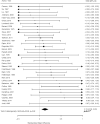Higher Circulating Cortisol in the Follicular vs. Luteal Phase of the Menstrual Cycle: A Meta-Analysis
- PMID: 32582024
- PMCID: PMC7280552
- DOI: 10.3389/fendo.2020.00311
Higher Circulating Cortisol in the Follicular vs. Luteal Phase of the Menstrual Cycle: A Meta-Analysis
Abstract
Although results of animal research show that interactions between stress and sex hormones are implicated in the development of affective disorders in women, translation of these findings to patients has been scarce. As a basic step toward advancing this field of research, we analyzed findings of studies which reported circulating cortisol levels in healthy women in the follicular vs. luteal phase of the menstrual cycle. We deemed this analysis critical not only to advance our understanding of basic physiology, but also as an important contrast to the findings of future studies evaluating stress and sex hormones in women with affective disorders. We hypothesized that cortisol levels would be lower in the follicular phase based on the proposition that changes in levels of potent GABAergic neurosteroids, including allopregnanolone, during the menstrual cycle dynamically change in the opposite direction relative to cortisol levels. Implementing strict inclusion criteria, we compiled results of high-quality studies involving 778 study participants to derive a standardized mean difference between circulating cortisol levels in the follicular vs. luteal phase of the menstrual cycle. In line with our hypothesis, our meta-analysis found that women in the follicular phase had higher cortisol levels than women in the luteal phase, with an overall Hedges' g of 0.13 (p < 0.01) for the random effects model. No significant between-study difference was detected, with the level of heterogeneity in the small range. Furthermore, there was no evidence of publication bias. As cortisol regulation is a delicate process, we review some of the basic mechanisms by which progesterone, its potent metabolites, and estradiol regulate cortisol output and circulation to contribute to the net effect of higher cortisol in the follicular phase.
Keywords: cortisol; follicular; hypothalamic-pituitary-adrenal (HPA) axis; hypothalamic-pituitary-gonadal (HPG) axis; luteal; menstrual cycle.
Copyright © 2020 Hamidovic, Karapetyan, Serdarevic, Choi, Eisenlohr-Moul and Pinna.
Figures



Similar articles
-
Luteal phase sertraline treatment of premenstrual dysphoric disorder (PMDD): Effects on markers of hypothalamic pituitary adrenal (HPA) axis activation and inflammation.Psychoneuroendocrinology. 2024 Nov;169:107145. doi: 10.1016/j.psyneuen.2024.107145. Epub 2024 Jul 24. Psychoneuroendocrinology. 2024. PMID: 39096755
-
Impact of gender, menstrual cycle phase, and oral contraceptives on the activity of the hypothalamus-pituitary-adrenal axis.Psychosom Med. 1999 Mar-Apr;61(2):154-62. doi: 10.1097/00006842-199903000-00006. Psychosom Med. 1999. PMID: 10204967
-
Pulsatile secretory characteristics of allopregnanolone, a neuroactive steroid, during the menstrual cycle and in amenorrheic subjects.Eur J Endocrinol. 2002 Mar;146(3):347-56. doi: 10.1530/eje.0.1460347. Eur J Endocrinol. 2002. PMID: 11888841 Clinical Trial.
-
Changes in concentrations of cervicovaginal immune mediators across the menstrual cycle: a systematic review and meta-analysis of individual patient data.BMC Med. 2022 Oct 5;20(1):353. doi: 10.1186/s12916-022-02532-9. BMC Med. 2022. PMID: 36195867 Free PMC article.
-
Impact of the menstrual cycle on peripheral vascular function in premenopausal women: systematic review and meta-analysis.Am J Physiol Heart Circ Physiol. 2020 Dec 1;319(6):H1327-H1337. doi: 10.1152/ajpheart.00341.2020. Epub 2020 Oct 16. Am J Physiol Heart Circ Physiol. 2020. PMID: 33064553
Cited by
-
Childhood adversity predicts stronger premenstrual mood worsening, stress appraisal and cortisol decrease in women with Premenstrual Dysphoric Disorder.Front Endocrinol (Lausanne). 2023 Nov 2;14:1278531. doi: 10.3389/fendo.2023.1278531. eCollection 2023. Front Endocrinol (Lausanne). 2023. PMID: 38027112 Free PMC article.
-
Luteal phase sertraline treatment of premenstrual dysphoric disorder (PMDD): Effects on markers of hypothalamic pituitary adrenal (HPA) axis activation and inflammation.Psychoneuroendocrinology. 2024 Nov;169:107145. doi: 10.1016/j.psyneuen.2024.107145. Epub 2024 Jul 24. Psychoneuroendocrinology. 2024. PMID: 39096755
-
Depression in Women: Potential Biological and Sociocultural Factors Driving the Sex Effect.Neuropsychobiology. 2024;83(1):2-16. doi: 10.1159/000531588. Epub 2024 Jan 25. Neuropsychobiology. 2024. PMID: 38272005 Free PMC article. Review.
-
Sleep Reactivity and Related Factors in Adolescence: An Increased Risk for Insomnia? A Longitudinal Assessment.Nat Sci Sleep. 2023 Apr 11;15:207-216. doi: 10.2147/NSS.S401452. eCollection 2023. Nat Sci Sleep. 2023. PMID: 37069845 Free PMC article.
-
Daily associations between salivary cortisol and electroencephalographic-assessed sleep: a 15-day intensive longitudinal study.Sleep. 2024 Sep 9;47(9):zsae087. doi: 10.1093/sleep/zsae087. Sleep. 2024. PMID: 38587464 Free PMC article.
References
Publication types
MeSH terms
Substances
Grants and funding
LinkOut - more resources
Full Text Sources
Research Materials

